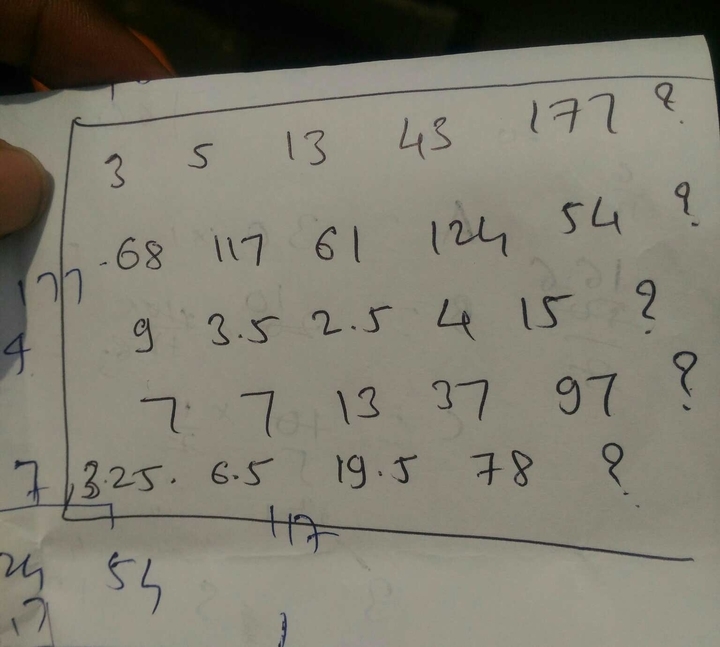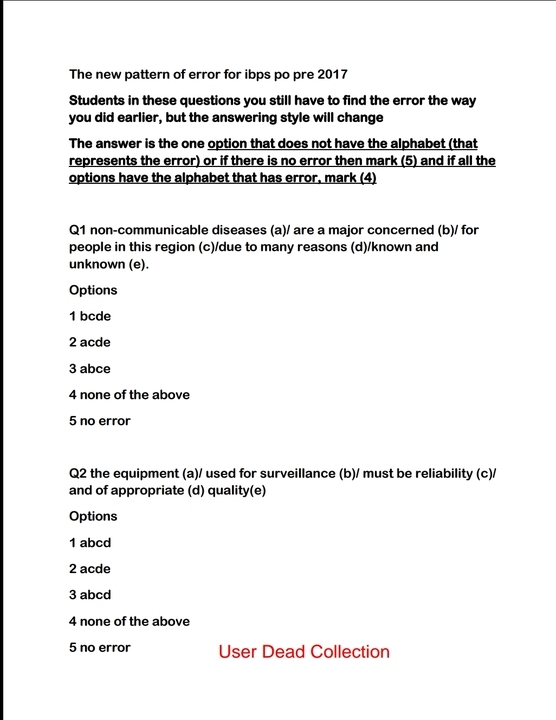IBPS PO Memory Based Questions (Prelims) 2017: 7th Oct- Shift 2
Dear Aspirants,
Reasoning Section: (Easy to Moderate)(Based On Memory)
Puzzles Asked were
- A certain number of people are sitting in a horizontal line facing north. Rajan sits fouth from the left end. Seema sits third to the right of Rajan. Puja is right of Seema. There are as many as people sitting between Puja & Digvijay as many as between Seema & Puja. Digvijay sits at the right end.
- Eight people sitting on a circular table A,B,C,D,P,Q,R & S. Four are facing facing the centre and the others are facing outside. Q sits third the left of D. Neither A & S nor P is the neighbour of Q. P sits second to the right of S. S not sitting next to D. Immediate neighbours of Q are facing opposite direction to Q. The neighbours of C are facing the centre.
- Eight people sitting in a line facing north P,Q,R,S,T,U,V & W. And each of the belong to the different age groups 8,11,15,17,19,21,23 & 25.
- A, B, C, D, E, F and G are seven friends, all of a different height and fatness.
(I) B is the thinnest and tallest among them.
(II) D is not as short as E, but shorter than C.
(III) G is not as Fat as C, but Fatter than F.
(IV) C and E are taller than G but shorter than A.
(V) F is fatter than E and the shortest among them.
(VI) C is third among them in fatness in descending order.
Inequality Section (Easy Level)
No Syllogism Asked
Quantitative Aptitude (Easy to Moderate Level)
- No. Series Questions – 5 Questions (3-easy,2-moderate)

- 2 Sets of Data Interpretation – 10 Questions (Easy) (Based on the given data you have to calculate aaverage, ratio, percentage)
Data Interpretation – The Line Graph was given as below & questions on ratio, averages & differences are asked.

- No Quadratic Equation Questions Asked
- Partnership Questions- Easy Level
- Problem Based on Ages -Easy Level
The sum of ages of 4 people was given. The ratio of ages of 4 people 4 years ago was given. You have to calculate the present age of the asked person. - Appproximation- Easy Level
DATA INTERPRETATION QUESTION SET ASKED IN SLOT 2 OF IBPS PO PRELIMS 2017
Direction: Read the given data and answer the following question.
Each student in the class either participate in any one of the events or don’t participate in any events.
| Classed of school | Total number of students | Total no of student who didn’t participate in any of the competition | Ratio between no of students who participated in singing and dance |
| V | 450 | 330 | 7:3 |
| VII | 340 | 160 | 4:5 |
| VIII | 330 | 225 | 3:4 |
| IX | 400 | 240 | 3:5 |
| X | 300 | 215 | 2:3 |
Q.1) What is the difference between the number student, who participate in dance from class V & VII to number of students who participate in singing from same class.
- a) 25
- b) 28
- c) 35
- d) 20
- e) 30
Q.2 Number of students who participate in dance competition from class VIII is what percentage of number of students who don’t participate in any of the events from class IX.
- a) 20%
- b) 25%
- c) 30%
- d) 35%
- e) 40%
Q.3 The total number of students who participated in dance competition from class XI is 5/9th those who participated in singing from class VIII. What number of students participated in dance from class XI ?
- a) 29
- b) 26
- c) 31
- d) 20
- e) 33
Q.4 What is the total number students who participated in dance from all the classes?
- a) 447
- b) 387
- c) 347
- d) 367
- e) 417
Q.5 What is the difference between total number of students who participated in singing from all classes to total number of students who participated in reasoning from all classes?
- a) 43
- b) 53
- c) 58
- d) 71
- e) 34
English (Easy to Moderate Level)
- Reading Comprehension- 10 Questions Asked (2- Antonyms, 2- Synonyms)Massa’s story would be familiar to many coffee farmers in Uganda, and around the world. Coffee is highly vulnerable to climate change. Rising temperatures and increasingly erratic rainfall are already exposing trees to more pests and diseases, and decreasing both the quantity and quality of the crop, according to a global survey of coffee research published in September. Overall, the survey found that climate pressure could reduce the area suitable worldwide for coffee production 50 percent by 2050. That would be a devastating blow to the global coffee supply, which is already struggling to keep pace with rising demand. A paper published in Nature in June made similar dire predictions for Ethiopia, driving home the point for East Africa.
For coffee addicts in the U.S. and Europe, these impacts will likely manifest as a slightly higher bill for a slightly worse cup of coffee. But for the world’s 25 million coffee farmers, most of whom are smallholders like Massa whose fortunes rise and fall with the harvest, the consequences will be much more dire.
Uganda is especially vulnerable, because coffee is the country’s economic cornerstone. Now, scientists, government officials, farmers, and entrepreneurs, from the top of Mount Elgon to downtown Kampala to remote areas still reeling from warlord Joseph Kony, are scrambling to save the industry from climate change.
Uganda ranks number eight worldwide in coffee production by volume, on par with Peru, and second in Africa after Ethiopia. Uganda typically produces 3-4 million 60-kilogram bags of coffee each year, which accounts for only two to three percent of global production and is far below behemoths like Brazil (55 million bags) or Vietnam (25 million). The majority of what Ugandan farmers grow is Robusta, a relatively low-quality variety that is often used for mass production—think Folgers, rather than your local hipster roastery.
Nevertheless, over the past century, coffee here has advanced into Uganda’s most important and valuable industry, worth more than $400 million. It’s responsible for at least 20 percent of the country’s export revenue, and according to the Uganda Coffee Federation, one in five Ugandans, nearly eight million people, derive most or all of their income from coffee. Roughly 90 percent of the country’s coffee is produced by smallholders like Massa.
President Yoweri Museveni, who has ruled Uganda since 1986 and cultivates a folky farmer-statesman persona, refers to coffee as an “anti-poverty crop” and is pushing an ambitious (and according to many experts here, completely unattainable) goal of increasing production five-fold, to 20 million bags by 2020. Coffee demand worldwide is projected to double by 2050, and Uganda wants in. It could be a solution to a variety of chronic social problems, particularly the rural poverty and food insecurity that afflict one-quarter of the population, and a $3.3 billion trade deficit (Uganda spends twice as much on petroleum imports as it earns from coffee).
But challenges abound, even without climate change. Farmers often lack access to basic equipment like fertilizer, irrigation, and high-quality seeds; services like bank loans, agricultural training, and market data; and infrastructure like paved roads and processing facilities. Most farms are small—the larger ones no bigger than a football field—and with a rapidly growing rural population, the land is divided into ever-smaller pieces. Weak land rights laws leave small farmers exposed to land grabs by wealthy neighbors or foreign investors. Many young people would rather try their luck in Kampala than follow their parents onto the farm. Women are frequently sidelined because land and household finances are traditionally controlled by men.
Overall, Uganda’s coffee farming practices have not advanced much since the time of Massa’s forebears, and farming incomes have stagnated among the lowest levels in Africa. As a result, farmers here are at a disadvantage to compete in a global market increasingly characterized by mechanization and unforgiving quality standards—and they’re entering the fight against climate change with one hand tied behind their backs. - Phrasal Replacemets – 5-10 Questions (Easy- Moderate)
- No Parajumble Questions Asked
- Spotting Error- 15-20 Questions (Easy to Moderate Level)
Spotting Error has new pattern. A sentence will be given with marked portion A,B,C,D,E. This time you have to identify the part which contains error and you have to mark the ans which parts are corrects iin the given sentence.
For Example:-

One who is having good speed can easily attempt 60 questions with acccuracy,
ALL THE BEST.








